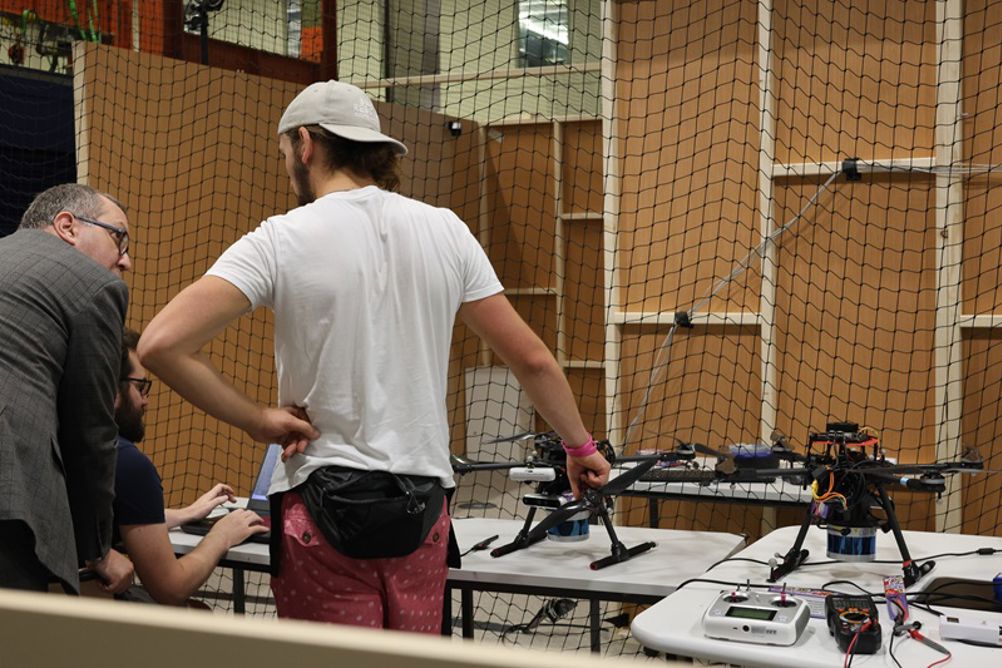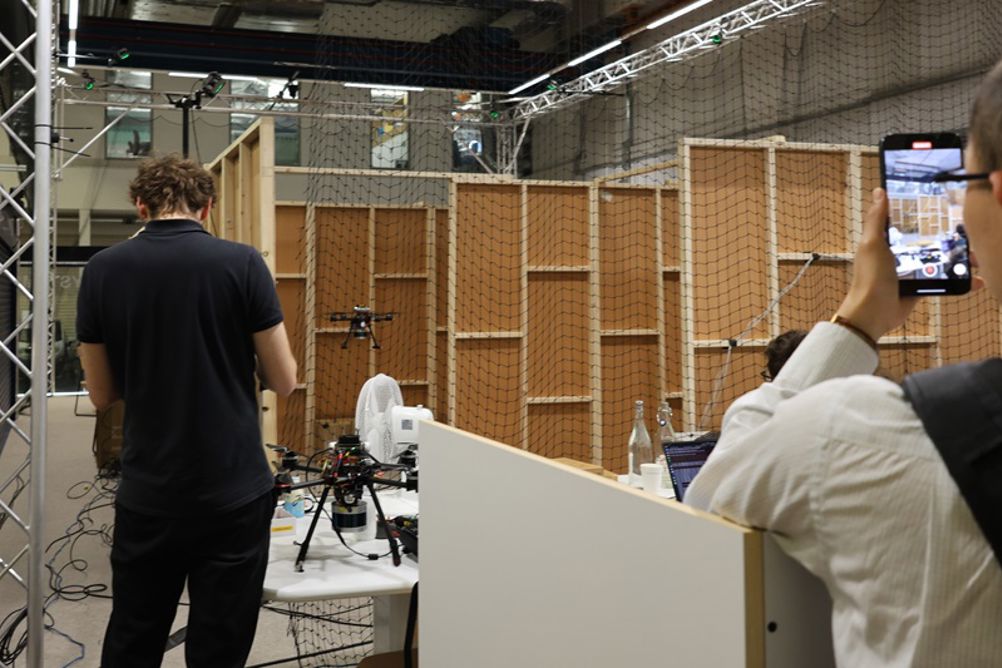PWC’s latest Skies Without Limits report predicts that drones could contribute up to £45bn to the UK economy by 2030. It’s clear to see why: engineers are continually pushing the boundaries of this technology for a growing range of applications.
The Engineer was invited to witness one particular area of advancement in drone capabilities: search and rescue operations. As part of the €1.2m SAPIENCE (Sense & Avoid - a cooPeratIvE droNe CompEtition) programme, funded through NATO’s Science for Peace and Security (SPS) scheme, the event is one of the first to test fully autonomously controlled drones without human interaction.
“SAPIENCE is encouraging participating teams to compete with each other to demonstrate best solutions and approaches to completing tasks based on real-world scenarios,” said Ettore Marchesoni, SPS advisor and programme manager. “It is grounded in technical challenges identified by the NATO Unmanned Aircraft Systems (UAS) community, such as sensing and avoidance, navigation in GNSS-denied environments, and fault tolerance.
“The competition pushes forward the complexity of autonomy in the direction of multi-agent systems, seeking to show when multiple autonomous drones can simplify the job of first responders when they intervene in a disaster scenario.
“Under the leadership of academics and researchers, the teams are mainly composed of students in the early stages of their academic careers, whose involvement is essential not only to the success of SAPIENCE, but for the future of the technologies it explores.”
Drones in the basement
The first phase of the competition was hosted by City St George’s, University of London, at its campus in Clerkenwell, London. Hidden in the basement of the university’s Augmented and Virtual Reality Learning Centre is an Autonomous Systems Arena – designed to replicate a ‘rescue room’ in a disaster stricken building – in which the drones were put to the test.
Four university teams took place in the first phase event, made up of MSc and PhD students from four collaborating institutions: the host team, City St George’s, University of London, representing the UK; the University of Alabama, Huntsville, from the USA; Delft University of Technology, for the Netherlands; and the University of Klagenfurt, representing Austria.
Each team – made up of one professor, one academic supervisor and six students – began the event with up to two of their own customised and co-operative drones, with the option of enhancing their software with artificial intelligence (AI) to autonomously control them.

The drones could also be equipped with the options of LIDAR (laser imaging, detection, and ranging) and depth-sensing cameras to aid autonomous navigation.
For this first event, the drones were required to manoeuvre through the unknown, confined spaces of the building – with the teams only being able to practise for a total of five hours in the new environment prior to the competition – and create detailed maps of the specific rescue room area.
Additionally, the drones had to identify people in need, simulated with mannequins; detect hazards and obstacles; and deliver aid to those requiring assistance.
“The cheering of the audience was evidence of the thrill of seeing two drones operating autonomously, and that of the participating teams was a clear sign of relief and satisfaction after all the preparations of the past months,” said Marchesoni.
“We did not only see success. We saw crashes, components overheating and malfunctioning, but this also happens in the real world. What is perhaps most important is that we saw teams supporting each other, sharing parts, technical solutions, solving problems on the spot, and learning from each other. This is a great foundation for the next two challenges of the SAPIENCE project, and to draw [on the] lessons learned.”
Picking a winner
A panel of judges awarded up to 30 points for each test. Teams were awarded points based on how quickly the task was completed, while penalties were given for time delays and straying outside of the boundaries of the rescue areas.
The overall winner of the London leg was the City St George’s host team, who were commended by the judges for their ‘wide implementation of AI in their approach toward the competition tasks.’
When asked what set the winning drones apart, Maxwell Hogan, a PhD Student at City St George’s responsible for instrumentation and algorithms in the team’s software, told The Engineer: “Our drone is based on an off-the-shelf platform with many custom enhancements.
“These include specialised hardware such as the onboard sensor suite, which includes LiDAR and RGBD cameras, as well as the GPU-enhanced Jetson Orin Nano companion computer. While the sensor suite allows the drone to perceive the world around it, it is the novel AI algorithms deployed on the companion PC that enable it to comprehend its environment.
“The drone’s obstacle avoidance and navigation are driven by an AI model trained using Deep Reinforcement Learning (DRL), specifically employing the Twin Delayed Deep Deterministic Policy Gradient (TD3) algorithm. The AI was trained with a reward structure based on the deviation from an idealised action, which was determined using an Artificial Potential Field (APF). This APF creates a repulsive force from obstacles and an attractive force toward target locations, guiding the drone’s path. Initially, the AI model was trained in a simulated environment to ensure safety and reliability before being integrated into the drone hardware.”

The winning team used two drones to complete the tasks, coordinated by a base station responsible for assigning each drone’s individual route. A graph-based DRL algorithm was developed using two Graph Convolutional Network layers with edge weighting, followed by a fully connected network (FCN) that selected the next node – or point in the network or diagram – to visit.
“Each node contained data on whether it had been visited or was occupied by a drone. The algorithm was trained on random graphs to find efficient paths, with rewards for choosing unvisited nearby nodes and penalties for selecting nodes occupied by the other drone, previously visited nodes, or distant nodes,” added Hogan.
But even the winning team experienced setbacks: “One of the primary engineering challenges we faced was the failure of the Visual Simultaneous Localisation and Mapping (VSLAM) algorithm in tight spaces like corridors,” explained PhD student Abdulla Tammam, responsible for navigation and control algorithms.
“VSLAM struggled to maintain accurate positioning in these confined areas due to the lack of distinct visual features, making it difficult for the drone to reliably map and navigate its environment. To address this, we implemented alternative strategies, such as switching to LidarSLAM for improved odometry data and integrating depth cameras to mitigate Z-axis drift.”
From simulation to the real-world
The team said they also found the differences between the simulated environment and the real-world performance of the drone challenging. While the simulation allowed the students to develop their AI model and tune its parameters in a controlled setting, the real-world competition conditions introduced unforeseen factors, such as the drone’s momentum affecting its movement around obstacles.
Looking ahead, the City St George’s team hopes to refine its technology in the following phases of the competition. Set to take place over the coming two years, the next phase will happen outdoors in Alabama, followed by an event in Delft featuring both indoor and outdoor elements.
“The objective of those events is to enhance and advance the autonomy levels of our drones by integrating increasingly sophisticated AI solutions derived from our internationally recognised research,” said Professor Nabil Aouf, lead on the SAPIENCE project at City St George’s, University of London.
“I am confident that such initiatives and research endeavours will facilitate the development of fully AI-driven autonomous drones capable of collaboratively executing complex tasks, such as search and rescue operations, without the need for human intervention.”











Comment: New oil is a lose-lose for the offshore economy
The spill map from the <u>every day</u> link in the report looks to be roughly 400km × 400km @ say 100m average depth = 16,000 cubic <b>kilometres...